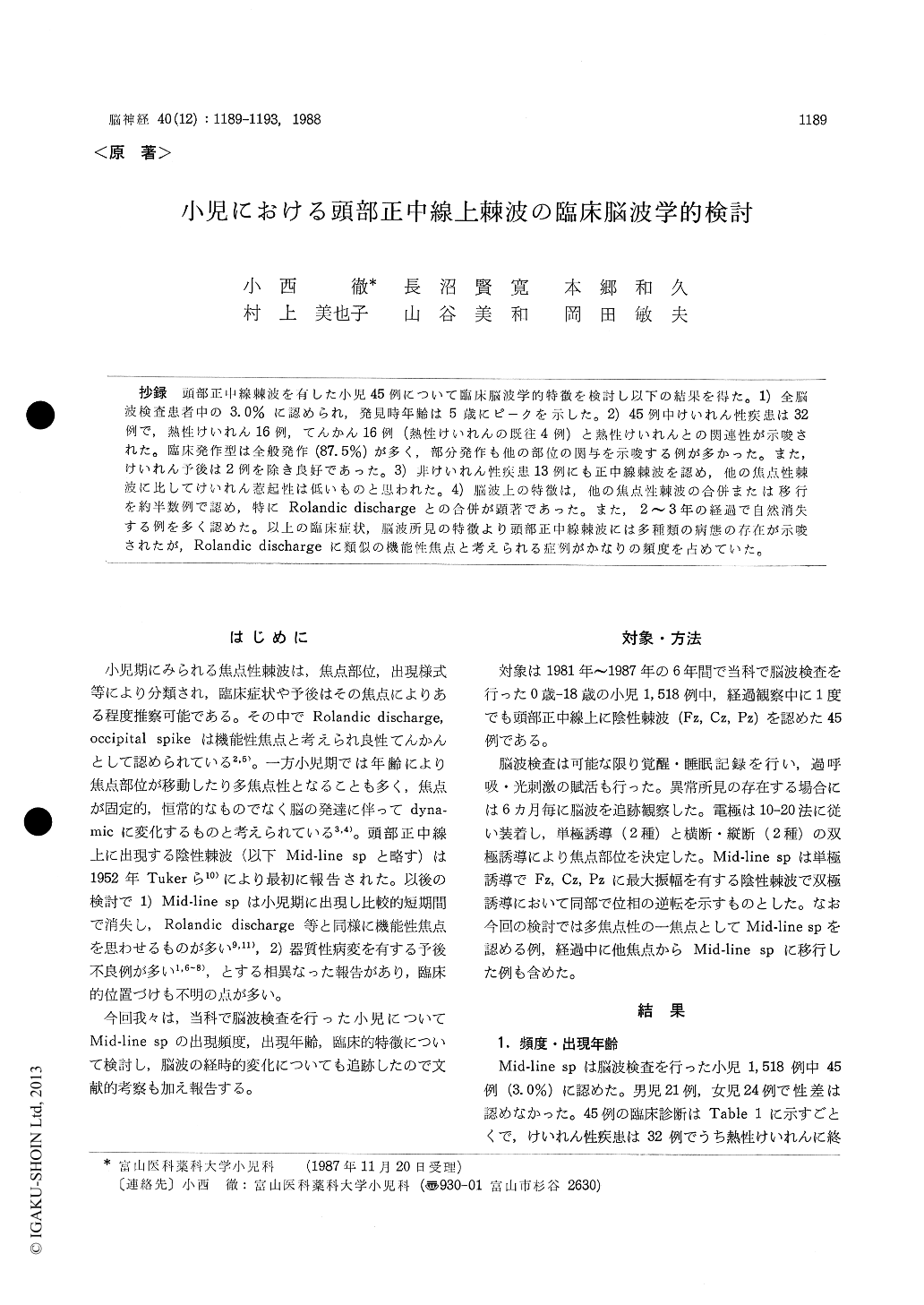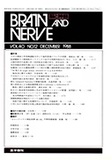Japanese
English
- 有料閲覧
- Abstract 文献概要
- 1ページ目 Look Inside
抄録 頭部正中線棘波を有した小児45例について臨床脳波学的特徴を検討し以下の結果を得た。1)全脳波検査患者中の3.0%に認められ,発見時年齢は5歳にピークを示した。2)45例中けいれん性疾患は32例で,熱性けいれん16例,てんかん16例(熱性けいれんの既往4例)と熱性けいれんとの関連性が示唆された。臨床発作型は全般発作(87.5%)が多く,部分発作も他の部位の関与を示唆する例が多かった。また,けいれん予後は2例を除き良好であった。3)非けいれん性疾患13例にも正中線棘波を認め,他の焦点性棘波に比してけいれん惹起性は低いものと思われた。4)脳波上の特徴は,他の焦点性棘波の合併または移行を約半数例で認め,特にRolandic dischargeとの合併が顕著であった。また,2〜3年の経過で自然消失する例を多く認めた。以上の臨床症状,脳波所見の特徴より頭部正中線棘波には多種類の病態の存在が示唆されたが,Rolandic dischargeに類似の機能性焦点と考えられる症例がかなりの頻度を占めていた。
We studied the clinical and electroencephalo-graphic (EEG) characteristics of 45 patients with mid-line spikes. The incidence of mid-line spikes was 3.0% in total EEG population in childhood. Sex incidence was equal. First appearance age of mid-line spikes ranged from one month to 12 years, with a mean of 5.0 years old. Fz focus was in 3 patients, Cz in 31 and Pz in 11. Thirty two of the 45 patients (71%) had a history of clinical seizures ; 16 with febrile con-vulsions and 16 with epileptic seizures. Of the remaining 13 patients without a history of sei-zures, the EEG was obtained because of post-meningitis in 4, developmental delayed in 4, migraine in 1 and miscellaneous in 4. Mid-line spikes might not have so strong correlations with clincal seizures. Ten patients had a family history of epilepsy and/or febrile convulsion. In the patients with seizures, generalized tonic-clonic seizures were the most frequent type (18 ; primary GTC and 10 ; secondary GTC with partial onset). Elementary symptoms of partial seizures werevery variable (focal motor in 5, Jacksonian march in 1, versive in 1 autonomic in 2 and automatism in 5), and which might be related to the other lesions such as temporal and/or frontal lobes. Seizure control was almost good except for two patients with organic brain damage. And other neurological symtoms were not also progressive. On EEG findings, twenty-two patients had mid-line spikes as their only epileptiform abnormality. The remaining twenty-three had an additional epileptiform feature, either a focal spikes or a generalized spike-wave. These focal spikes com-bined to mid-line spike as to be multifocally in same EEG tracing, and migrated or propagated to and from mid-line focus in serial EEGs. Rolan-dic discharge was most common in additional paroxysmals. In one third of the patients, mid-line spikes diminished spontaneously during two or three years, with a mean duration of 2. 3 years. The pathogensis of the mid-line spikes remains unknown. Our results may suggest that there are several different mechanisms in the genesis of mid-line spikes. These possible mechanisms were as follows ; 1) may represent generalized epile-ptiform abnormalities, 2) may have a property of functional focus resembled to Rolandic discharge or may have a same epileptogenesis to Rolandic discharge, 3) may be a secondary focus from the other epileptogenic focus, and 4) may be generated from mesial parasagittal cortical epileptogenic focus and may easy propagate to the frontal and temporal lobe. In the majority of our patients with mid-line spikes, first two mechanisms may be rea-sonable to explain the clinical and EEG manifes-tations.

Copyright © 1988, Igaku-Shoin Ltd. All rights reserved.


